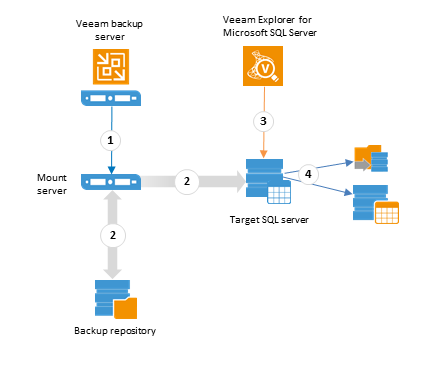 This document is not supported any longer.
This document is not supported any longer.How It Works: SQL Server Database Restore
Veeam Backup & Replication supports several methods of SQL Server restore from the backup. They are based on Veeam’s patented vPower technology that allows you to run a VM directly from a compressed and deduplicated backup file, eliminating the need to extract the backup and copy it to production storage. Instead, Veeam exposes the VM files in a backup repository through a disk mount. Local disk space is used as a temporary write area while the VM is running from the backup. This approach is used to carry out the whole VM restore with Instant VM Recovery, Full VM Restore, as well as to perform VM disk recovery or file-level restore of the guest OS (see https://helpcenter.veeam.com/backup/vsphere/data_recovery.html for more information on restore options).
Veeam Backup & Replication also offers a convenient tool to extend the set of restore options – Veeam Explorer for Microsoft SQL Server, installed together with Veeam Backup & Replication server or standalone console as a part of Veeam setup. This tool helps you to restore databases from the SQL Server image-level backup to the original or different location, without a need to recover the whole server VM. The basic restore procedure includes the following steps:

- The backup administrator uses Veeam Backup & Replication restore options to mount database files from the SQL Server's backup, making database hierarchy available for browsing and search.
- Veeam Explorer for Microsoft SQL Server obtains SQL Server hierarchy information (instances and databases) and presents it to user, facilitating browsing and search. A user selects and follows the necessary database restore scenario.
Veeam Explorer for Microsoft SQL Server supports several scenarios that are similar for database restore and export:
- Restore/export to current restore point (the one currently mounted to Veeam backup server)
- Restore/export to selected point in time
- Restore/export to the state before selected transaction.
The first scenario involves target SQL Server only; others involve target and staging SQL Servers, as follows:
| Restore scenario | Export scenario | ||
| To point in time | To selected transaction | To point in time | To selected transaction |
Staging SQL Server | Not involved | Yes (involved; presents log to user) | Yes (involved) | Yes (involved; presents log to user, supports log replay) |
Target SQL Server | Yes (involved; supports log replay) | Yes (involved; supports log replay) | Not involved | Not involved |
- Finally, the database is ‘re-created’ on the target Microsoft SQL Server and becomes ready for use. If the export scenario was used, exported database can be then attached to the SQL Server you need.
|
For more information, refer to https://helpcenter.veeam.com/backup/explorers/vesql_hiw.html. |